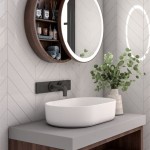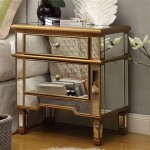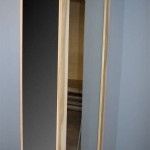How To Mount a Heavy Mirror On The Wall
Mounting a heavy mirror on a wall requires careful planning, the right tools, and a thorough understanding of wall structure. Improper installation can lead to the mirror falling, causing damage to the mirror, the wall, and potentially causing injury. This article provides a step-by-step guide to safely and effectively mount a heavy mirror, focusing on key considerations and best practices.
1. Assessing the Wall and Mirror
The first step is to thoroughly examine the wall and the mirror. Understanding the wall type (drywall, plaster, brick, or concrete) is crucial because each material requires different mounting hardware and techniques. Drywall, while common, offers the least structural support and requires special anchors for heavy items. Plaster, often found in older homes, can be brittle and prone to cracking, so gentler techniques are needed. Brick and concrete offer the most robust support but require specialized drilling and anchors. The weight of the mirror also dictates the type and number of anchors required. Always overestimate the weight to account for any additional stress on the mounting hardware.
To assess the wall type, carefully examine the surface. Drywall will often have a smooth, slightly textured finish and will feel hollow when tapped. Plaster typically has a harder, more textured surface and may have a layer of lath underneath. Brick and concrete are easily identifiable by their visual appearance and density. Consult building plans or contact a professional if uncertain about the wall’s composition. Once the wall type is determined, the mirror should be weighed accurately. Using a bathroom scale is a simple method. This weight will be a critical factor in selecting appropriate mounting hardware.
Furthermore, the location of wall studs needs to be identified. Wall studs are vertical wooden or metal beams that provide structural support within the wall. Mounting the mirror directly to a stud is the strongest and most secure option. Stud finders, either electronic or magnetic, are useful tools for locating studs. An electronic stud finder detects changes in density behind the wall, while a magnetic stud finder identifies nails or screws that are used to attach the drywall to the studs. If a stud cannot be located in the desired mounting location, heavy-duty wall anchors designed for the specific wall type and mirror weight will be needed.
2. Selecting the Appropriate Hardware
Choosing the correct mounting hardware is paramount for a secure and long-lasting installation. The hardware must be compatible with both the wall type and the weight of the mirror. For mounting to studs, heavy-duty screws, typically lag screws or wood screws, are recommended. The length of the screw should be sufficient to penetrate deep into the stud, generally at least 2 inches, to ensure a strong hold. The diameter of the screw should also be appropriate for the weight of the mirror.
When studs are not accessible, wall anchors are necessary. Several types of wall anchors are available, each designed for different weight capacities and wall types. Toggle bolts are a reliable option for drywall and plaster walls. They consist of a bolt with a hinged "toggle" that folds flat to pass through a hole in the wall and then expands behind the wall to provide a secure hold. Molly bolts, also known as sleeve anchors, are another option for drywall. These anchors expand as a screw is tightened, gripping the back of the wall. Heavy-duty plastic anchors are suitable for lighter mirrors and can be used in drywall, plaster, or concrete walls. However, it is essential to carefully review the weight rating of these anchors to ensure they meet the needs of the project.
For brick and concrete walls, specialized anchors designed for masonry are required. These anchors typically involve drilling a hole into the brick or concrete and inserting an expanding anchor that provides a strong hold. Sleeve anchors, wedge anchors, and concrete screws are common choices. It is crucial to use a hammer drill with a masonry bit to create the pilot hole and to follow the manufacturer's instructions carefully when installing these anchors.
In addition to the anchors and screws, consider the hanging hardware on the mirror itself. D-rings, wire, and sawtooth hangers are common options. Ensure that the hanging hardware is securely attached to the mirror frame and can support the weight of the mirror. If the existing hardware appears inadequate, it may need to be replaced with stronger components. Wire should be heavy-gauge steel wire, and D-rings should be attached to the mirror frame with strong screws. Proper mounting hardware selection will significantly minimize the risk of the mirror falling.
3. Installation Procedure
Before starting the installation, gather all necessary tools and materials. This includes a stud finder, level, drill (with appropriate drill bits for the wall type), screwdriver, measuring tape, pencil, safety glasses, and the chosen mounting hardware. Wearing safety glasses is crucial to protect the eyes from dust and debris. Clear the area around the wall to provide ample workspace and protect the floor with a drop cloth.
Begin by marking the desired location for the mirror on the wall. Use a level to ensure the mark is straight. If mounting to a stud, locate the center of the stud and mark the location for the screw. If using wall anchors, mark the locations for the anchor holes, ensuring they are properly spaced according to the mirror's hanging hardware and the anchor manufacturer’s instructions. It is advisable to create a template by tracing the mirror's hanging hardware onto a piece of paper. This template can then be taped to the wall to accurately mark the drill locations.
Drill pilot holes at the marked locations, using the appropriate drill bit for the wall type. For drywall, a standard drill bit is sufficient. For plaster, use a slow speed and gentle pressure to avoid cracking the plaster. For brick and concrete, use a hammer drill with a masonry bit. The pilot hole should be slightly smaller than the diameter of the anchor or screw to ensure a snug fit. After drilling, clean out any dust or debris from the holes.
Install the chosen anchors into the pilot holes, following the manufacturer's instructions. For toggle bolts, fold the toggle flat, insert it through the hole, and then tighten the bolt until the toggle expands behind the wall. For molly bolts, insert the bolt through the mirror's hanging hardware and then into the anchor. Tighten the bolt to expand the anchor. For masonry anchors, insert the anchor into the hole and then use a hammer to drive it fully into the wall. Once the anchors are installed, attach the mounting hardware (screws or hooks) to the anchors, leaving enough of the screw or hook exposed to hang the mirror.
Carefully lift the mirror and align the hanging hardware with the screws or hooks on the wall. Gently hang the mirror, ensuring that it is securely supported. Use a level to check that the mirror is straight and make any necessary adjustments. If the mirror is not level, slightly adjust the position of the screws or hooks until it is properly aligned. Once the mirror is securely mounted and level, double-check that all screws and anchors are tightly fastened. Apply gentle pressure to the mirror to confirm its stability. A well-mounted mirror will remain firmly in place and will not wobble or shift.
After the mirror is mounted, clean any smudges or fingerprints from the glass surface. Inspect the wall around the mirror for any damage caused during the installation process. If necessary, touch up any paint or repair any minor damage to the wall. Proper mounting ensures the safety and longevity of the mirror, while also enhancing the aesthetics of the room.

How To Hang A Large Or Heavy Mirror
How To Hang A 100 Pound Mirror On Drywall Quora

How To Hang A Heavy Mirror The Home Depot

How To Hang A Heavy Mirror With Pictures Wikihow
:strip_icc()/ScreenShot2022-04-28at1.12.19PM-e055476c70c6438585fa7c5cd531edcf.png?strip=all)
4 Easy Ways To Hang A Heavy Mirror

How To Hang A Heavy Mirror The Home Depot

How To Hang A Very Heavy Picture Or Mirror The Best

How To Hang A Heavy Mirror Without Nails S Or Drilling Velcro Brand

How To Hang A Heavy Mirror With French Cleat

How To Hang A Heavy Mirror In 5 Simple Steps







